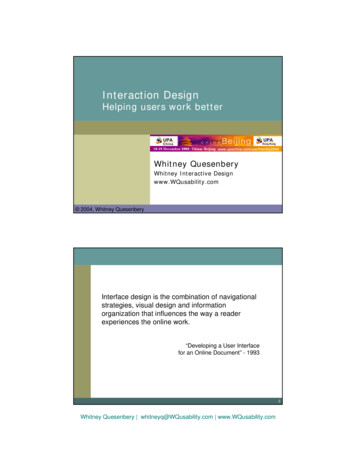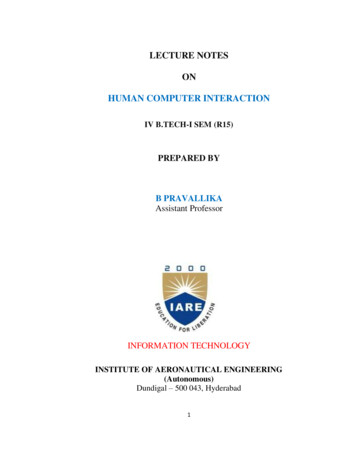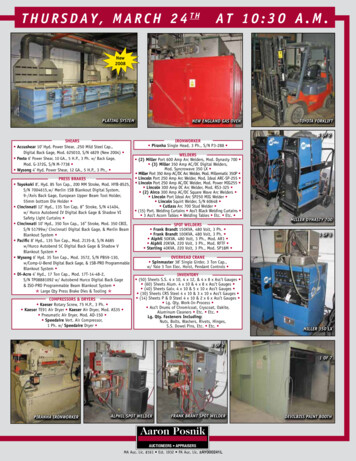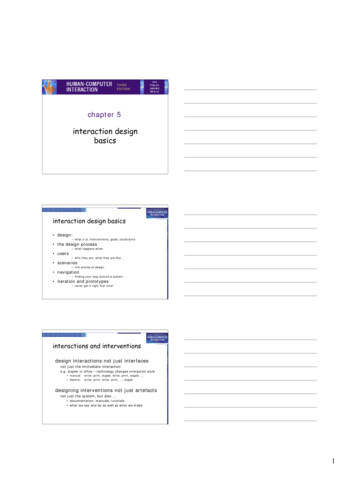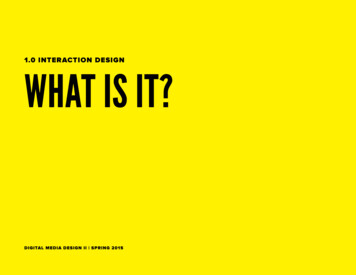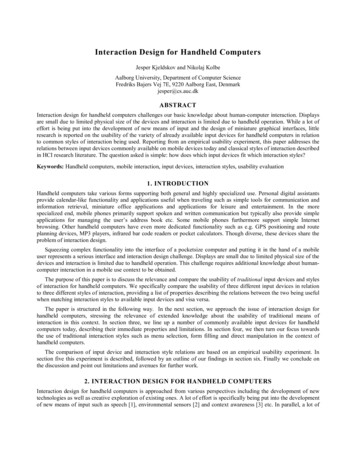
Transcription
Human-ComputerInteraction & DesignPerancangan Interaksi - Genap 1819
AGENDATopicWeekWeekTopic1Human-computer Interaction & Design9Project 1 : Usability Testing2Human-computer Interaction & Design10Project 2: Design Thinking3Psychology 10111Project 2: Design Thinking4Design Principles12Project 2: Design Thinking5Interaction Styles and Devices13UI Design Tutorial6Project 1 : Usability Testing14Project 2 : Design Thinking7Project 1 : Usability Testing15Project 2 : Design Thinking8Mid Term Exam16Project Presentation
Human-Computer InteractionHistory of HCIVision of HCIDesignCommonly used termsAGENDA
PRE-TEST / WARMING-UP( waktu 30 menit )Apa itu UX Designer dan UI Designer ?Apa persamaan dan perbedaan UX dan UI Designer ?Apa saja Elemen UX ?Apa itu Emotional Design ?Apa itu Mental Model ?Coba Desainkan Tempat minum dan Botol Kecap yang Ideal menurut anda !
PEMBAHASAN
Berbagai Definisi dari UX Designer1.Craft user value and visualize user flows into beautiful, testable productdesigns. Craft user value ini sedikit sudah diterjemahkan ke Bahasa Indonesia.Mungkin arti terdekatnya: “Membuat produk yang bermanfaat danmemvisualisasi user flows menjadi disain produk yang teruji dan indah.”2. Merubah cara orang berinteraksi dengan produk digital. Menggunakansemua keahlian di disain produk, disain interaksi, dan disain visual untukmembuat ‘magical experience’.
Berbagai Definisi dari UX Designer3. Kompeten dalam semua tahap dari proses disain, pengalamanhands-on di disain visual, user research, dan sangat berbakatserta terampil dalam Interaction and Information kap,menghubungkan antara kebutuhan bisnis, inovasi, dan disainyang baik. Seorang komunikator hebat dengan pengalaman yangintensif untuk kolaborasi lintas fungsional yang luas dan bisamenyeimbangkan kebutuhan pengguna dan tujuan bisnis.
Berbagai Definisi dari UX Designer4. Membayangkan bagaimana orang menggunakan produk dan membawavisi tersebut menjadi kenyataan dengan cara yang menginspirasi, lebihbaik, dan mengejutkan. Menangani hal yang kompleks dan mengubahnyamenjadi disain yang intuitif, bisa diakses, dan mudah digunakan untukseluruh orang di dunia—dari pengguna pertama sampai pengguna yangahli. Untuk tujuan ini, diperlukan kolaborasi dengan tim disain, peneliti,engineer, dan product manager selama proses disain—dari mulaimembuat user flows dan wireframes, sampai membuat mockup danprototype. Di setiap tahap, mengantisipasi apa yang dibutuhkanpengguna, mengadvokasi mereka, dan memastikan bahwa produk akhiritu mengejutkan dan membuat senang pengguna.
Jadi Definisi dari UX DesignerOrang yang dengan keahlian disainnya, berkolaborasi dengan berbagai lintasfungsional, mencari ‘sweet spot’ antara kebutuhan pengguna, tujuan bisnis,dan kemajuan teknologi, kemudian membuat ‘magical experience’ melaluidisain produk yang bermakna, berguna, dan menyenangkan (meaningful,useful, dan enjoyable).
Kepanjangan? Coba kita sederhanakan.UX Designer: Orang dgn keahlian disain, berkolaborasi utk produk yanglebih baik dgn mencari ‘sweet spot’ antara pengguna-bisnis-teknologi( 140 karakter )
Lapisan 1. Fondasi. Kebutuhan Penggunadan Tujuan Bisnis.User Experience dibangun dari bawah ke atas. Sama halnya denganmembangun gedung, yang dibawah adalah fondasinya. Sebagus apapunhiasan (dalam hal ini warna, font, gambar/foto, icon), jika fondasinya tidakkuat, maka UX nya bisa roboh.Fondasi di UX, adalah Strategi—Kebutuhan Pengguna dan Tujuan Bisnis(User Needs dan Business Goals). Untuk mengerti pengguna dan bisnis,Anda wajib bicara dan ketemu langsung dengan pengguna dan tim bisnis(termasuk product manager, management, bahkan bisa jadi sampai CEO)
Lapisan 2. Cakupan. Features dan Content.Setelah mengerti tentang pengguna dan bisnis, baru lanjut ke lapisanselanjutnya, yaitu bicara tentang Scope/Cakupan. Apa features dancontent yang bisa memuaskan kebutuhan pengguna dan memenuhi targetbisnis? Dalam menentukan Scope ini, belum dibahas implementasi detailnya, tapi lebih ke deskripsi saja. Untuk memetakan features/content ini,saya sering menggunakan Kano Model. Di Kano Model, paling tidak ada 3klasifikasi utama dari features/content:
Lapisan 2. Cakupan. Features dan Content.1.Must-be/Expected/Wajib: Ini features/contenyang jadi syarat untuk Anda bisa masuk kepasar/kompetisi.2.Desired/Performance: Denganfeatures/content ini, Anda bisa tetapkompetitif/stay in the market.3.Delighters/Excitement: Dengan ini, Andamenonjol di banding kompetitor, world class.
Lapisan 3. Struktur. InformationArchitecture dan Interaction Design.Di lapisan ke-3 ini, mulai dibuat user flow dan struktur informasi.Bagaimana pengguna berinteraksi dengan produk Anda, daninformasi/data apa saya yang dibutuhkan, termasuk struktur datanya. Ditahap ini, belum bicara/diskusi tentang wireframes (detail dariscreen/webpage). Ini contoh dari user flow:
Lapisan 3. Struktur. InformationArchitecture dan Interaction Design.
Lapisan 3. Struktur. InformationArchitecture dan Interaction Design.
Lapisan 4. Rangka/Skeleton. Wireframes.Di lapisan ke-4, ini yang biasanya kita sebut wireframes. Disini UI Designdimulai. Di wireframes, semua hal yang tadinya abstrak (dari mulai userneeds, business goals, features/content, sampai user flow/informationarchitecture), dibuat nyata/tangible. Di tahap ini, mulai dipikirkan navigasi,layout, pemilihan komponen (misalnya radio box, dropdown, button, dll),dan bagaimana informasi ditampilkan.Semuanya ini tetap sejalan dengan lapisan 1-Strategi: kebutuhanpengguna dan tujuan bisnis. Untuk setiap penambahan screen, pemilihankomponen, penambahan langkah, Anda mesti selalu bertanya, bagaimanapenambahan/pemilihan tersebut bisa membantu pengguna memenuhikebutuhannya, atau membantu bisnis mencapai tujuannya.
Lapisan 4. Rangka/Skeleton. Wireframes.
Lapisan ke-5. Permukaan/Surface.Visual Design.Di tahap paling atas ini, barulah kita ‘mempercantik’ wireframes/skeleton dilapisan ke-4. Yang termasuk di tahap permukaan, aphyCopy Writing Style
Dengan mengerti elemen yang membangun User Experience, idealnyaAnda akan memiliki pendekatan yang berbeda saat mendesign produk.Ketimbang langsung lompat membuat wireframes, atau malah langsungmembuat design lengkap dengan warna, icon, dan gambar, Anda akanmulai dari fondasi: mencari tahu apa kebutuhan pengguna (termasukpain points/kesulitan, unmet needs-kebutuhan yang belum adapenyedia layanannya) dan memastikan Anda memahami apa tujuanbisnis (hal yang membuat bisnis bisa sukses). Membuat design(wireframes/visual design) relatif mudah, yang jauh lebih sulit adalahmencari tahu masalah yang penting untuk dipecahkan.
Presentasi Ide Kelompok (Tiap Kelompok 10 menit )
HumanComputerInteraction
Aaron Marcus. 2002. Dare we define user-interface design?. Interactions 9, 5 (September 2002), 19-24. DOI ceA computer-mediated means to facilitatecommunication between human beings orbetween a human being and an artifact.
UserInterface
User Interface
User Interface
Interaction Design FoundationHuman-ComputerInteractionHuman-Computer Interaction (HCI) is amultidisciplinary field of study focusingon the design of computer technologyand, in particular, the interactionbetween humans (the users) andcomputers.
Human-Computer InteractionMichel Beaudoin-Lafon. 2017. Foundation of Human-Computer Interaction Lecture
Michel Beaudoin-Lafon. 2017. Foundation of Human-Computer Interaction LectureReal world situation is complicated.1. Interaction happenssimultaneously2. Interaction happens with morethan 1 user3. Interaction happens more than1 way4. User’s focus is divided5. User is interacting with aremore than 1 artifact/computer
Michel Beaudoin-Lafon. 2017. Foundation of Human-Computer Interaction LectureAn interactive system is NOTInteractive system is not an algorithmic system that:- Reads input- Processes it- Writes resultsWhy?- You cannot always predict human input- Human don’t think sequentially- Real world situation is messy
Michel Beaudoin-Lafon. 2017. Foundation of Human-Computer Interaction LectureAn interactive system isInteractive system is computer system that:- Holds an internal state- Creates perceivable representations of part of thisstate- Reacts to input as soon as it arrives
Michel Beaudoin-Lafon. 2017. Foundation of Human-Computer Interaction LectureProperties of interactive systemReactive:U provides input to S,S must process it immediately and generate output to UOpen:dependencies between S’s outputand U’s future input are unknown to SAsymmetry:U does not have to react immediately to SU likes to know the dependencies between S’s input and output
Michel Beaudoin-Lafon. 2017. Foundation of Human-Computer Interaction LectureConceptual modelModel of how interactive system operatesIdeally, matches the user’s mental model
Nielsen-Norman GroupUser’s Mental ModelA mental model is based on belief, not factsit's a model of what users know (or think they know)about a system such as your website.Individual users each have their own mental modelThe way user think may be different to what designerswant the user to think! So always test your design!
History ofHuman-ComputerInteraction
Why do we need to learn history?We need to know the important contributions in the fieldWe repeat what has been done in the pastThere is no idea that goes straight to product Idea is refined, tested, adapted to get to the market Thus to develop product we need to see what research has been done in the past We could have INVENTED the products we see today, 20 years ago
History of Computer Science1810 - Charles Babbage & Ada Lovelace createdfirst computing machine1936 - Alan Turing introduced algorithm1941 - first program-controlled hardware1946 - von Neumann designed computerarchitecture1948 - Shannon and information theory
What about Human-Computer Interaction?1963 - The invention of the mouse?1973 - The invention of Graphical User Interface?1985 - First multitouch device?
Memex by Vannevar Bush (1945)Electromechanical system for“Memory and Index”Vision for desktopinformation managementsystemOpen, edit, save, search, andstore documents
Sketchpad by Ivan Sutherland (1963)Direct manipulation geometric shapesZoom, click, drag -- just like today’s touch screen/pen based screen
NLS/Augment Doug Engelbart (1968)1.The mouse2.Bi-manual interaction3.Live text editing4.Video Conferencing system
Harnessing collective intellect, facilitated by interactive computers, became hislife's mission at a time when computers were viewed as number crunching tools.--Augmenting Human Intellect, Doug Engelbart
Xerox Star - Xerox PARC (1981)First graphical workstationDocument-centric approach
Macintosh - Apple (1984)Graphical personal computer til today
World-wide web - Tim Berners-Lee (1990)Networked hypertextIntegrated browser editor
What does history tell you?
Vision of Human-Computer InteractionNLS/AugmentAugmenting human intellect, cooperative work VXerox StarPersonal use, document centric VMacintosh VWorld-wide webPersonal use, application centricNetworked, but poor user-interaction, browsing butnot editing
What do you think about the future?
HCI does NOT follow Moore’s Law
The long nose ofinnovationNew technologies in the market has gone throughmany years of refinement and augmentation
Timeline ofInterfacetechnologydevelopment
Evolution of the desk
Future of Human-Computer InteractionThings will move beyond desktopHCI is not only about things on the screenKick start innovation through inventionsMultidiscipline approach
Design
video
Definition of DesignA DisciplineA ProcessAn ArtifactA discipline that explores theA process that defines aAn artifact produced as thedialogue between products,solution to help peopleresult of solution definition.people, and contexts.achieve their goals.
Design is.CommunicationProblem-SolvingDesign is communicating a message to the user.Design is solving a user’s problem. We do design inUsers need to receive the message clearly from thethe first place because there is a real problem thatsystem by the design.needs to be addressed.
Why Design?
Why Design?
Benefits of Good DesignShorter learning timeSaferHigher productivityMore enjoyableFewer errorsMore profitable!
Multidisciplinary Approach
Multidisciplinary Approach
Design Key StagesLearnDesignTo build a design we need to first learnThe actual design process can includeabout the user and the problem they have.diverging and converging between ideas,After we have a design we can dodo design reviews among designers andevaluation of our design.build the prototype.Methodologies:Methodologies:- User research (interview, observation,- Brainstormingsurvey)- Sketching- Usability Testing- Wireframing- Persona- Paper prototyping- High fidelity prototype
Common Design ProcessesDesign ThinkingLeanAgile
Design Thinking
Lean UX
Agile UX
Modification, example XD Studio
Modification, A Combination
Common termsin the field
1.User Experience (UX)“"User experience" encompasses all aspects ofthe end-user's interaction with the company,its services, and its products.- Nielsen Norman GroupProduct,Company,ServiceUX
UX Designer?Good UX is a GOAL of the whole companyTo have a good UX needs good product, good brand, good strategy,good marketing, good service, and so onDesigners’ job usually is to build the system, product and service thatallowed those different experiences to happen. Experience is the builtfrom all product, system, or service in the company.Try to not use the term UX Designer unless you do everythingyourself! :)
UX ResearchYes! UX can be observed and thus researched!UX Researcher’s job is to find out how is the experience user orcustomer have from a product, service, or system.But again sometimes the term UX is too broad, usually researchers domore specific tasks like user research, market research, productresearch, design research,
2. User Interface (UI)“A computer-mediated means to facilitatecommunication between human beings orbetween a human being and an artifact.ProductUI
UI Designer?A UI Designer works on good layout/flow as well aspretty visuals.But pretty UI design is not always good design!UI Designer today usually have skills from VisualDesign or Graphic Design.What skills should UI Design in the future have?Remember user interface is also evolving.
3. Interaction Design (Ix)“Ix defines the structure and behavior ofinteractive systems, to create meaningfulrelationships between people and the productsand services that they use.(Ix Design Association, 2003).ProductUIIx
Interaction Designer?Interaction designer usually goes beyond the userinterface.They need to understand user’s behaviour, whatmotivates user to do things.They are concerned also about content, engagement,logic, and usability.
4. Product Design?5. Product Experience?6. Service Design?7. Customer Experience?etcSimilar! but usually the scope is the different
Thanks!Any questions?
Week Topic Week Topic 1 Human-computer Interaction & Design 9 Project 1 : Usability Testing 2 Human-computer Interaction & Design 10 Project 2: Design Thinking 3 Psychology 101 11 Project 2: Design Thinking 4 Design Principles 12 Project 2: Design Thinking 5 Interaction Styles and Devices 13 UI Design Tutorial 6 Project 1 : Usability Testing 14 Project 2 : Design Thinking 7 Project 1 .

